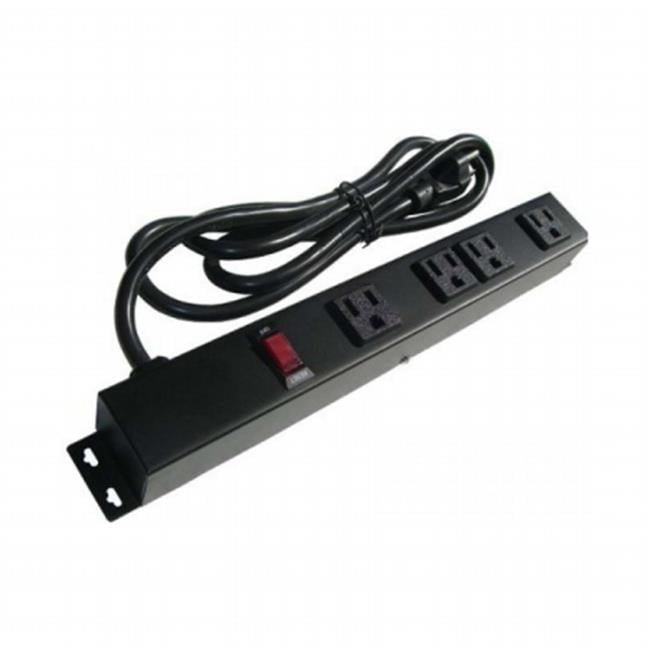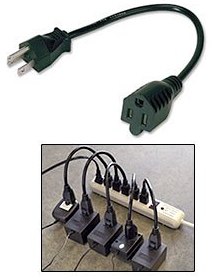|
|
Post by JFrankParnell on Apr 9, 2018 19:17:21 GMT -5
 My bass pedal board only has 3 things on it, 'bass fly rig', 'line6 wireless receiver', 'sony portable speaker'. Each has its own unique wall wart. The fly rig has a regular ol' 9v, like most pedals. The line6 wireless is a great product, except, its a 5v usb connector. Why they picked that, on a unit that is marketed to sit on your pedal board, idunno. And, also, this sony speaker that I'm using for craps and giggles, while dinking around with accoustics, is 15v.  So, i really dont think i need 3 wall warts, if I had some way of powering all 3 things off one powersupply. Maybe the 15v, with transformers, down to 9v and 5v? And then, how to have the 5v output its power, with the usb connection? Any thoughts or workarounds welcomed. |
|
|
|
Post by reTrEaD on Apr 9, 2018 21:20:15 GMT -5
If you had a dozen pedals or so, it might be worth using a single source power supply but since you only have three units to be powered, it seems like management of the existing wall warts might be a better choice. You're on the other side of the pond, so your mains connectors will be different. But I reckon you should be able to find a power strip that has 4 to 6 outlets. Here's what such things look like over here:  You could plug in your wall warts, then use zip ties to prevent them from rattling loose during transport. If you find one with mounting flanges, you could attach it permanently to the board. |
|
|
|
Post by sumgai on Apr 9, 2018 21:56:24 GMT -5
reTrEaD,
I dunno who yer talkin' at, but JFrankParnell lives just a hop, step and a jump from my place. Well, maybe a couple of jumps, but he's really only a 70 or 80 minute drive from here (on beautiful downtown PickleFarm Road!). He even visited my old place once for an amp tune-up, and thus he's the only member who can claim to have met The Real Boss.
JFrank, I'm gonna go with reTrEaD here, if only for no other reason than cost. You simply can't build anything for nearly as cheap as you can purchase a low-socket-count strip, and firmly attach each of the power supplies thereto. If you search on the web for, and find, a multi-voltage supply of some repute, then I'm sure it'll cost you more than you might be happy about. But if it serves your purpose, then who am I to say no.
sumgai
|
|
|
|
Post by JFrankParnell on Apr 9, 2018 22:27:19 GMT -5
reTrEaD,
I dunno who yer talkin' at, but JFrankParnell lives just a hop, step and a jump from my place. Probly my use of the fancy, European word, ameliorate  edit: lol, or the Union Jack, behind me, on my profile pic! We were just goofin, on that day, as you might have surmised, from the hair-do  |
|
|
|
Post by JFrankParnell on Apr 10, 2018 0:59:51 GMT -5
Hrmm, i'm tempted to pig-tail 3 sockets, on the end of my main wire. At least I could arrange the different wall warts strategically, in my pedal case.
|
|
|
|
Post by reTrEaD on Apr 10, 2018 1:10:44 GMT -5
They make 1-foot extension cords with a single outlet. Get three of those and plug them into your three-outlet cord and you should be good to go. retrEaDIT: Something like this for the basic concept.  |
|
|
|
Post by newey on Apr 10, 2018 6:00:31 GMT -5
Power strips can nowadays be had with USB ports, so that could reduce your wart population by one.
|
|
|
|
Post by thetragichero on Apr 10, 2018 7:10:19 GMT -5
|
|
|
|
Post by newey on Apr 10, 2018 20:09:21 GMT -5
New housing construction now is often wired with USB ports on the mains outlet. The outlets above my kitchen counters may soon be upgraded with these, to "ameliorate" the cellphone/tablet/e-cig/whatnot wall warts currently metastasizing all over my kitchen (and the bedroom, too, now that I think of it. Maybe one for the music room, too.).  |
|
|
|
Post by thetragichero on Apr 10, 2018 20:37:48 GMT -5
i keep walking by them in the store (i practically get mail at home depot since my job now is replacing the floors in the house i live in), but the right of 20 or 30 clams for an outlet just feels weird to me
i see them in the future for the bedroom, though
|
|
|
|
Post by newey on Apr 10, 2018 21:23:17 GMT -5
|
|
|
|
Post by thetragichero on Apr 10, 2018 22:01:11 GMT -5
bookmarked!
|
|
|
|
Post by sumgai on Apr 11, 2018 10:58:07 GMT -5
traggie, Not so fast there, bunky. I looked at the link, and didn't like what I saw. Assuming that you live in North America, then you need to do your online shopping with due care and diligence. Here's what I found, in pretty much this order: 1) Brand name: Maxxima - not something you'd find in any store selling electrical parts, here in the USA. Umm, whyzat? 2) Picture of the back - only one connection screw per incoming wire, fails the UL test right there.* 2) No label, and in the description, no claim of UL listing or registration - fails again. 3) Claims ETL approval - looking up definition of ETL, we see: ETL Approval is an internationally recognized seal of Quality, Safety, and Professional Manufacturing. • It is only granted to companies after rigorous inspections and testing of the product. • The product is taken from the company and completely disassembled. (First result from a Bingle search.)
Note that nowhere in there do you see anything about testing for adherence to any country's Electric Code, let alone the USA. We have the UL (and in Canada it's the CSA), other countries have their equivalents. But here in this description, we see only the word "Safety", and I have to ask "What's that mean? Safety in what regard, because there's lots of ways to be unsafe..." In short, you can have the best manufacturing processes in the world, and make the highest quality product (it works, and it won't fall apart next week), but that doesn't mean that it's safe to use, at least not in the eyes of the UL, etc.
And finally, notice also that the ETL squeal of approval is granted to "a company", not to an individual component. They may test a component, but how many items does Maxxima make? Does the ETL test absolutely everything before granting their approval to a company? Arrrrrrrgh, that's too many questions!
Right about now, I'd be grabbing my wallet and heading for the door!
Sorry, but HTH.
sumgai
* The UL requires two screw connections for each incoming wire (excepting ground), regardless of how many push-in slots there might be. Seems like an outdated concept, but in fact, many non-qualified "electricians" will attempt to clamp down two or more wires under one screw, and that's just about the highest no-no you can do inside of an electrical box. Not quite a Cardinal Sin, but close enough for any City Electrical Inspector to reject the job.
p.s. Further discussion:
To All:
Notice that when you read a properly labeled device with a UL stamp, you will never see the word "Approved" - the UL does not approve of anything!! They do only two things, List and Register. If you do see "UL Approved", you're looking at a very suspicious item. But I wouldn't run to the authorities just yet, it has happened in the past that a company will make something, get it Listed, then outsource the sticker that goes on the item. That outsourcing company might not be so diligent about how they construct the wording on the label, and Voila, a violation of UL's terms and conditions is in the offing. So here, as in most things in life, trust your instincts. Either that, or get a second opinion from someone who should know!
|
|
|
|
Post by newey on Apr 11, 2018 11:56:15 GMT -5
|
|
|
|
Post by JFrankParnell on Apr 11, 2018 13:47:13 GMT -5
|
|
|
|
Post by sumgai on Apr 11, 2018 15:07:11 GMT -5
I wanted to check out the above power supply for more details. Guess what? Tom's Line has no website!! Bingle refused to cough up a single website for this guy, neither Tom's Line or Tomsline, or any other variant. All I got was reviews and sales pitches from various and sundry other websites, most of them reputable, but still, not the real thing.
For that reason alone (they're afraid to disclose their wares? Afraid to spend money on doing so?), I can't get behind this thing. But I will say, if you need to plug a 15v device into an 18v socket, there's a way to protect the effects device just in case.
1) Insert a 1 or 2 watt resistor, 470Ω to 1KΩ in value between the supply output and the device input. Yeah, this means some temporary jumpers. 2) Before applying power, hook up a meter at the device end of that resistor - you're checking for actual voltage when the powered device is operating. 3) Power up. If the meter reads approximately 15vDC, plus or minus 1v, then you're not likely to blow anything up, and the sound should be the same as you've always gotten. If the voltage is too low, reduce the resistance value. If it's too high, then take way it's blunt! 
I specifiy at least a 1 watt resistor because you're giving up some energy for the device, and that energy has to go somewhere.... it does, in the form of heat. The resistor will get warm, perhaps even hot to the touch. If it seems too hot, then go to a 2 watt component.
One more thing: If you want to know how much current is going through the resistor (and thus, how much current the device is taking), simply put both meter probes across that resistor, keeping your meter set for vDC. This reading, the known value of the resistor, and a judicious application of Ohm's Law will tell you the current draw. For the coup de gras, you can take the amperage and voltage readings, apply some more Ohm's Law, and determine just how many watts the resistor really needs to pass. Derate that finding by 50% in order to avoid overheating the resistor. (Example: if the result says "1 watt through the resistor", then use a 2 watt component, just for safety.)
HTH
sumgai
|
|